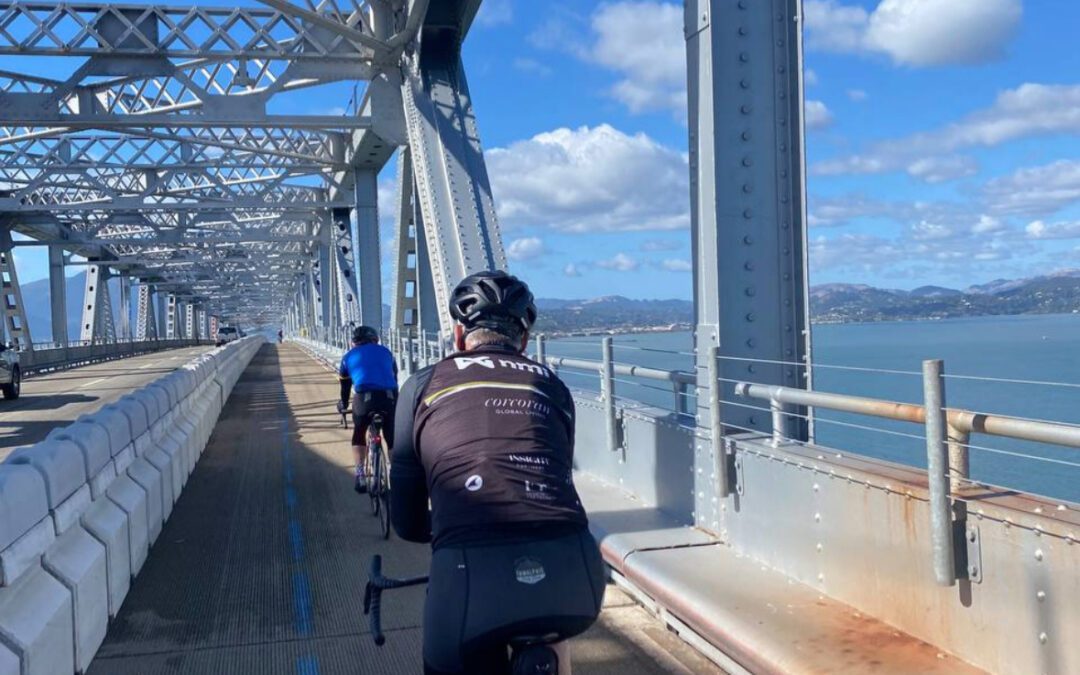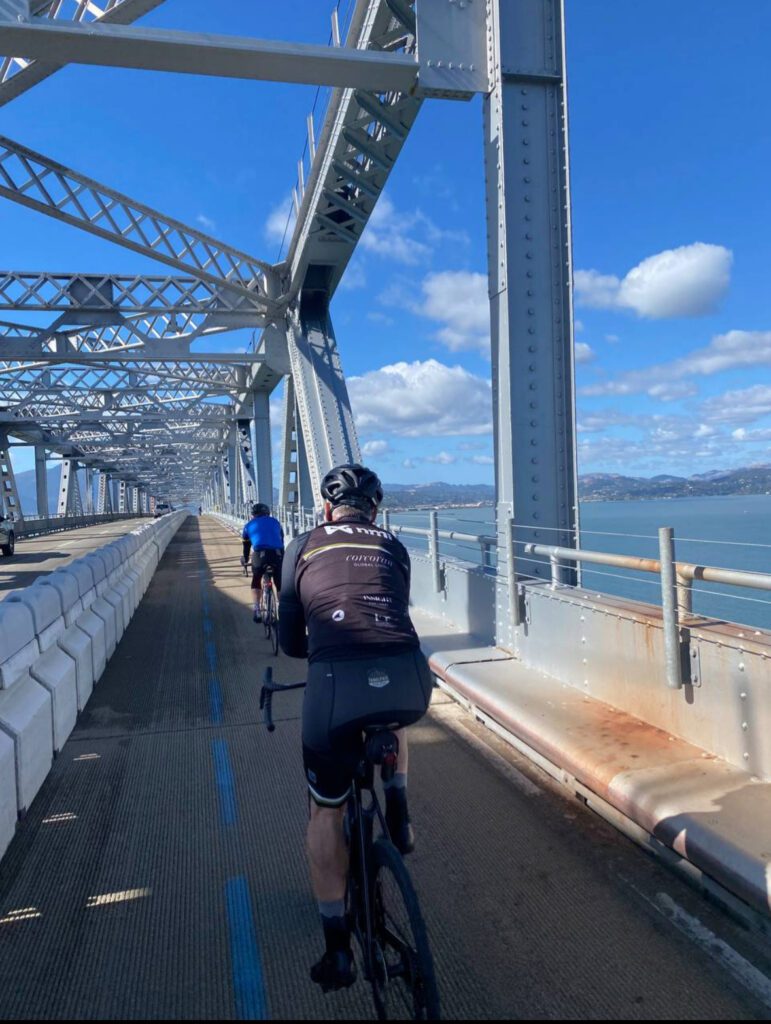As Mill Valley residents know well, there’s no doubt that the volume of people cruising on two wheels around Mill Valley over the past several years has taken off like a rocket ship. The primary driver of that increase has been pretty clear: safety.
As those who have been following the recent history of the Richmond Bridge, Marin County supervisors voted unanimously voted many months ago to write a letter to the San Francisco Bay Conservation and Development Commission urging that a pilot study be initiated to evaluate the effects of such a change.
There has been tremendous opposition: those who love the joy and safety of riding a bicycle across the bridge, and those who sit in traffic in both directions as they navigate their way to and from work.
Of late, it seems that the impact on day-to-day business trips for workers has become the larger focus, at least at the current moment.
A revised proposal to convert the Richmond-San Rafael Bridge bike path to a part-time feature is under review. Caltrans, which owns the bridge, and the Bay Area Toll Authority, which funds operations and maintenance of the span through toll revenue, submitted its revised application on Monday.
“The modified pilot is a forward-thinking approach that will benefit all corridor travelers,” the application said. “In conjunction with the complementary projects and studies, it will allow Caltrans and BATA to methodically understand the trade-offs through observed data and better serve the varied users traveling between Contra Costa and Marin counties.”
The San Francisco Bay Conservation and Development Commission, or BCDC, plans to hold a public hearing and possible vote on the proposal on Aug. 7, said Rylan Gervase, a spokesperson for the agency.
The barrier-protected, 10-foot, bidirectional path was introduced in 2019 as a four-year pilot project. Since its opening, the path has served as a success story for cyclists promoting access and connectivity, while commuting drivers complain that bridge traffic is worse than ever.
Last year, BATA and Caltrans proposed reopening the lane for emergency vehicles and breakdowns during weekdays, and then restoring the path on weekends in an attempt to strike a balance. The agencies submitted an initial application for the modification last summer, but disagreement over the plan led to delays.
Some data: The Richmond Bridge sees approximately 80,000 vehicles cross the bridge on weekdays.
In Peak hour traffic: Approximately 18,000 drivers attempt to cross the bridge in their cars or pickup trucks during the morning commute, resulting in significant congestion and delays, estimated at 16 minutes of stop-and-go traffic on average during peak hours. This congestion extends to local Richmond streets.
Traffic direction: Congestion is particularly noticeable in the eastbound direction (towards Richmond) during evening peak hours due to development in Contra Costa and Marin counties. To address this, a third lane has been added in the eastbound direction.
Toll Plaza Capacity: The Richmond-San Rafael Bridge Toll Plaza, with its seven lanes (including exclusive FasTrak and combined manual payment/FasTrak lanes), has a maximum capacity of approximately 4,225 vehicles per hour (vph). Current traffic volumes are within this capacity under current FasTrak usage levels (approximately 54% during peak periods).
Bridge path traffic: While not directly car usage, it’s worth noting the bridge also has a path for bicyclists and pedestrians. This path sees significantly less use compared to car traffic, averaging around 115 cyclists on weekdays and 325 on weekends. The path’s impact on peak bridge capacity and travel time variability on the Richmond approach has been studied, revealing a slight decrease in capacity and increased travel time variability
“Morning congestion has not increased since the movable barrier was put into place,” Talia Smith, the county’s legislative director, told supervisors earlier this year. “However, the incidence of traffic accidents has increased 33% since the multiuse path was put in place, and the effect has been an increased variability in morning commute times from the East Bay into Marin.”
The moveable barrier, which separates the multiuse lane from motor vehicles, prevents minor accidents or stalled cars or trucks from being immediately moved out of the path of traffic. Smith said that a number of local employers have told the county that the difficulty crossing the bridge in the mornings has affected their ability to recruit and retain employees. The proposal to open a third lane four days a week was supported by the Bay Area Council, the North Bay Leadership Council, the San Rafael Chamber of Commerce, Kaiser Permanente, MarinHealth, BioMarin, Marin Sanitary Service, the Marin County Office of Education and the Marin Association of Public Employees.
“The commuters traveling on the Richmond-San Rafael Bridge don’t have remote work options, and they don’t have transit options,” said Joanne Webster, chief executive officer of the North Bay Leadership Council. “These are commuters that typically work in the service sector. They’re construction, manufacturing, hospitality and health care workers. These sometimes unpredictable commute times can make employees late to work.”
Mark Shotwell, chief executive officer of Ritter Center in San Rafael, said, “The overwhelming majority of our staff live in the East Bay and have to travel across the Richmond-San Rafael Bridge every day. The commutes on the bridge can range from 45 minutes on a good day to 90 minutes or two hours or longer when there’s an accident on the bridge.”
Max Perrey, director of policy for Aliados Health, a network of community health centers, said Marin Community Clinics has about 160 employees — 29% of its workforce — who live in the East Bay and commute over the bridge.
“Any additional time it takes to cross the bridge during commute hours has a real impact on those employees’ lives,” Perrey said. “This in turn has a real effect on the health center’s ability to attract and retain a diverse workforce and to ensure continued access to care for patients.”
Smith, however, said the proposal was opposed by the Marin County Bicycle Coalition, Bike East Bay, Save the Bay, the San Francisco chapter of the Sierra Club and other nonprofit organizations.
Warren Wells, policy director for the Marin County Bicycle Coalition, said, “The long commutes faced by residents of the East Bay employed in Marin, among which I number, is the result of decades of exclusionary housing policy by the cities and towns in Marin and has nothing to do with the multiuse path on the bridge.”
Bruce Beyaert, chair of the Trails for Richmond Action Committee, said, “It makes no sense to shut down 5 miles of San Francisco Bay Trail linking the North Bay and the East Bay.”
Supervisor Stephanie Moulton-Peters said that means only about 70 bicyclists per day use the bridge on weekdays, since most riders make round trips. She said that by comparison, the Golden Gate Bridge averaged 3,000 bicycle trips per weekday in 2021 and 5,500 bicycle trips per day on weekends.
Moulton-Peters, the county’s representative on BCDC, acknowledged the results of the UC Berkeley study, but added, “The lived experience of people that we have heard from in this county and elsewhere is very different. We need to make a more reliable commute for the people coming from the East Bay to work in Marin.” Additional changes are planned for the bridge, including removing the toll booths at east end and reinstating a previous high occupancy vehicle lane on the westbound upper deck. Planners are also studying the possibility of using the multiuse lane as an additional lane for carpools and buses.
However, Klein said Caltrans has determined that the bridge will need structural strengthening before a third lane can be opened for full-time use by motor vehicles on a permanent basis.



